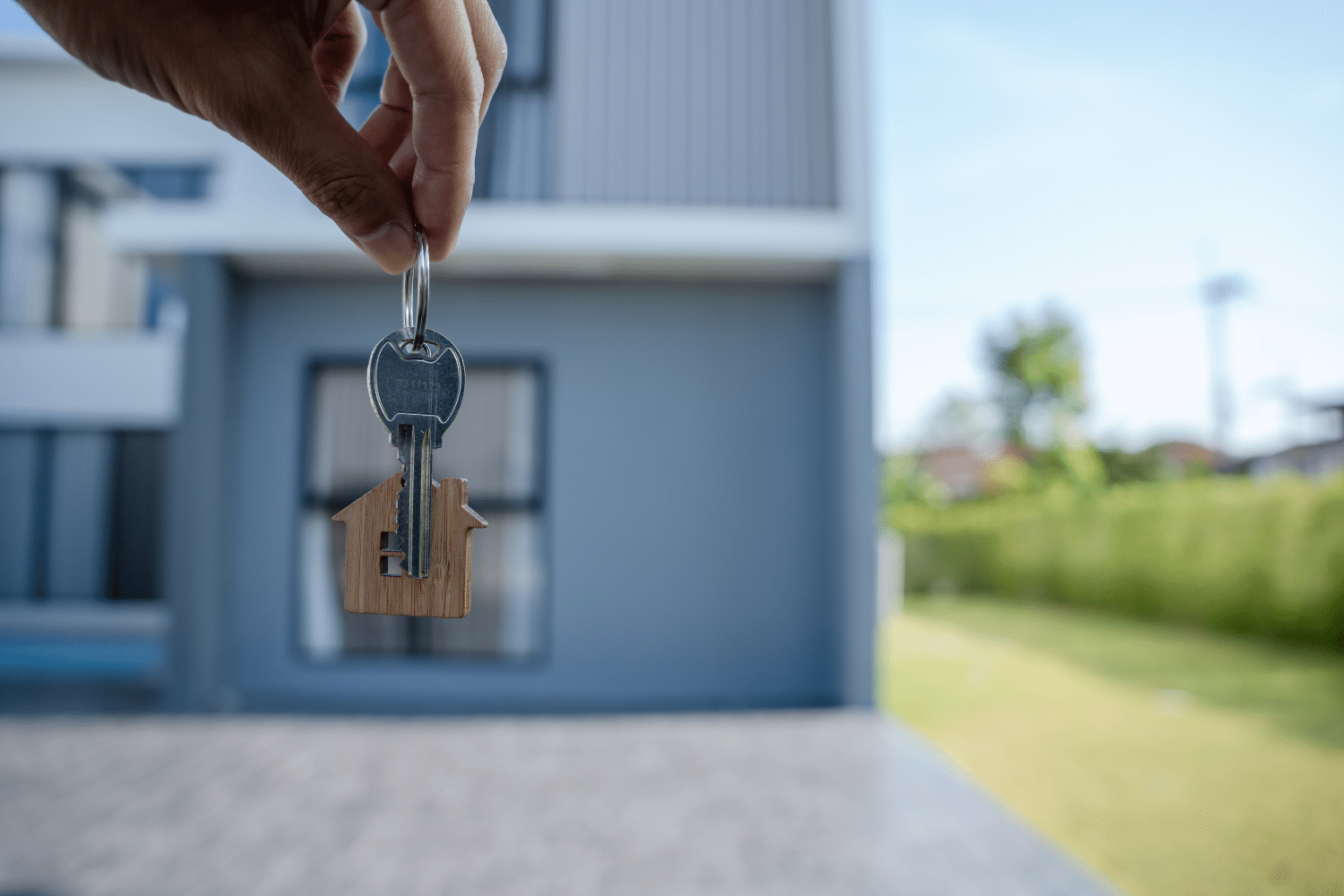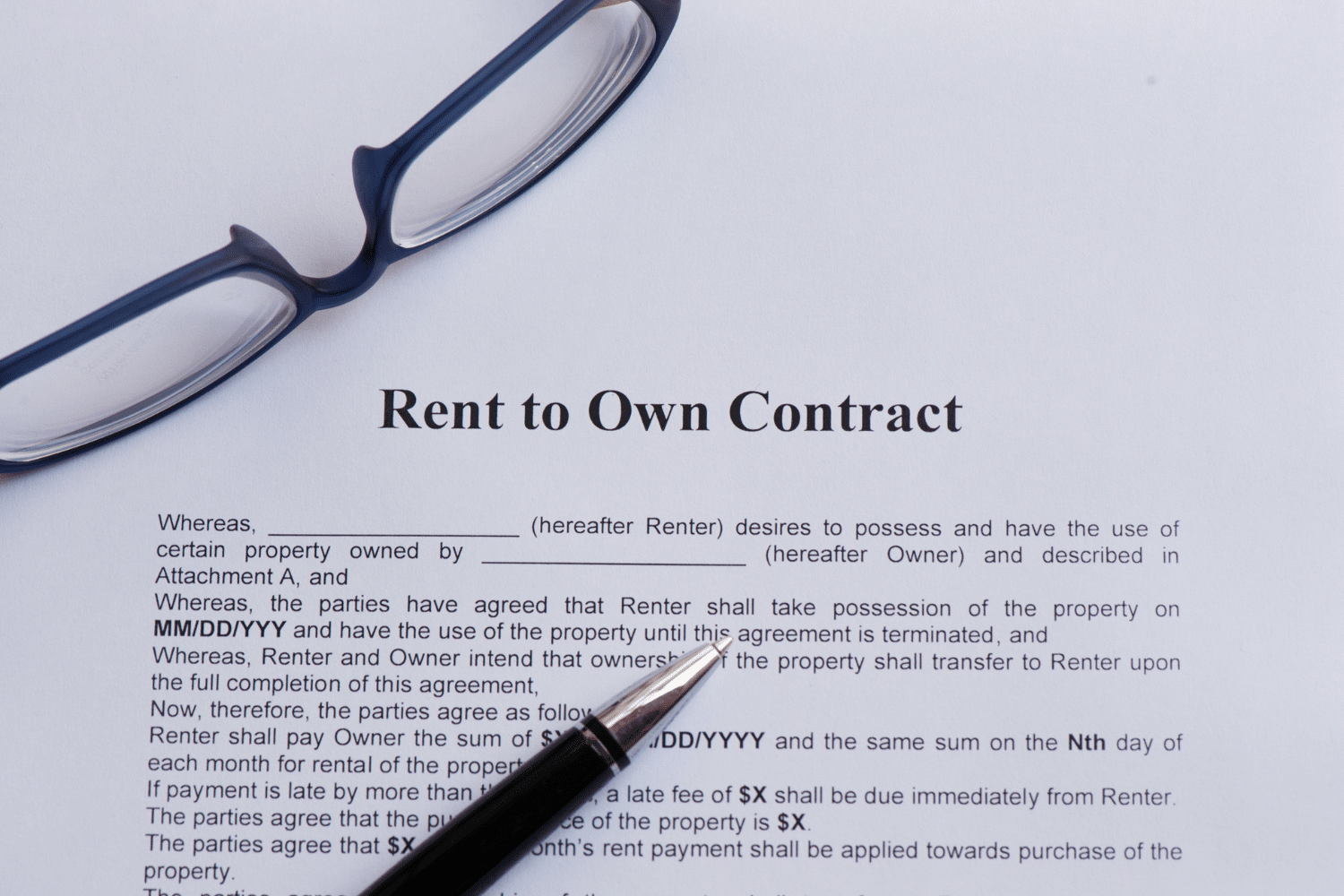When choosing your path to a home, the rent to own vs traditional buying decision is pivotal. Do you favor lower initial costs and the flexibility of renting with an option to buy? Or, do you prefer the immediate equity that comes with a traditional purchase? Our guide dives into both options, helping you make an informed choice tailored to your financial situation.
Key Takeaways
- Rent to own is a less immediate financial commitment with an option to buy the home after renting, while traditional buying requires immediate down payment and mortgage repayments.
- Rent to own may involve option fees and above-market rents where part of the rent goes towards a future down payment, whereas traditional buying builds equity directly through mortgage payments.
- Traditional buying offers immediate full control over the property with all the responsibilities that come with ownership, while rent to own provides a period to assess the property before committing to purchase.
Understanding Rent to Own and Traditional Buying
Imagine standing at a fork in the road. One path leads to traditional buying – a journey laden with immediate financial commitments, such as down payments and mortgages. The other path, rent to own, seems less daunting, with a rental agreement that includes an option or obligation to buy the rent to own home after a certain period, making the rent to own work for many people.
This path also allows you to build equity through a portion of your lease payments, without immediately requiring a down payment or mortgage. Understanding these basics is fundamental to deciding which homeownership route is best for you.
The Basics of Rent to Own

Rent to own is like taking a test drive before buying a car. It involves a lease agreement that gives you an option or obligation to purchase the rent to own property after a certain period. What’s more, a portion of your rent payments is set aside as a ‘rent credit’. This credit forms part of your down payment should you decide to buy the home at the end of the lease term. It’s like setting aside a portion of your spendings into a savings account each month.
However, the process isn’t as straightforward as it might seem. Lease-option agreements, a specific type of rent-to-own contract, require an upfront option fee. This non-refundable fee, typically 2% to 7% of the home’s value, gives you the right to buy the home later. But what if you choose not to buy? You lose the fee. Therefore, it’s imperative to be confident in the property and your financial ability to purchase it before signing a lease-option agreement.
Traditional Home Buying Overview
On the other hand, traditional home buying involves:
- A substantial down payment (usually 5-20% of the home’s purchase price)
- A mortgage
- Monthly mortgage payments that go towards paying off the principal and interest.
The traditional buying process includes steps such as property search, securing financing, making an offer, obtaining a home inspection, and closing on the purchase. Closing a home is not a walk in the park – it involves multiple steps and costs, including home appraisal, title search, and signing a significant amount of paperwork. Yet, once you’ve crossed the finish line, the home is all yours.
Comparing Financial Commitments: Rent to Own vs Traditional Buying
Once you’ve grasped the basics of rent-to-own and traditional buying, we can delve deeper into the financial commitments each entails. In rent to own, you pay an option fee instead of a down payment. This fee is often a percentage of the home’s price and provides the right, but not the obligation, to purchase the home at a later date. Your monthly payments include rent and a rent premium, part of which may be applied as a rent credit toward the purchase price.
On the flip side, when you opt for traditional buying, you make a down payment at the time of sale. Your mortgage payments then contribute to principal and interest, thus building equity in the home.
Initial Financial Outlay

In a rent-to-own agreement, you pay an option fee, usually between 1% and 5% of the purchase price. This fee secures your right to later purchase the home. For example, a home valued at $200,000 could have an option fee ranging from $2,000 to $10,000. This option fee is non-refundable and represents a significant financial risk if the purchase is not completed.
On the other hand, traditional buying demands a down payment, usually around 5-20% of the home’s purchase price, upon sale. For instance, a home valued at $200,000 would require a down payment of $10,000 to $40,000. A smaller down payment, however, leads to a larger monthly mortgage payment, impacting your long-term financial planning. It’s evident that rent-to-own agreements typically have lower initial financial outlays compared to traditional buying, where upfront costs can be substantial.
Monthly Payments Breakdown
Monthly payments in a rent-to-own scenario include the rental payment and a rent premium. This rent premium, typically 25% to 30% of the monthly rent, is set aside as a ‘rent credit’. This credit is applied to the home purchase down payment when executing the option to buy in lease-option agreements. However, some contracts may specify above-market rent payments with the understanding that the excess will be credited toward the home’s purchase – an aspect to be confirmed in the contract.
In traditional buying, your monthly payments serve to:
- Repay the principal and the interest on the loan
- No portion of these payments directly contributes to a future down payment
- Instead, these payments increase your stake in the property over time, helping to build equity.
Contractual Differences Between Rent to Own and Buying a House
The contractual obligations vary between rent-to-own and traditional buying. In rent to own, you sign a lease agreement with an option or obligation to purchase the home after a certain period. You may come across two types of agreements: lease-option agreements and lease-purchase agreements. These are the two types you should be aware of. Lease-option agreements offer flexibility, allowing you to opt out of purchasing the home.
Conversely, lease-purchase agreements require you to purchase the property. In traditional buying, you sign a mortgage contract to secure the loan needed to buy the property.
Understanding Lease Agreements

The lease agreement in a rent-to-own contract outlines the terms and responsibilities of both parties. This agreement includes details such as:
- The purchase price
- The term of the lease
- Whether you have the option to buy or are obligated to buy the property
- The responsibilities for property tax payments
- The responsibilities for maintenance and repairs of the property
It’s essential to conduct a professional home inspection before signing a lease-option agreement. This will help you assess the condition of the property and ensure the deal is equitable. After all, you wouldn’t want to commit to buying a home that needs considerable repair work, would you?
Mortgage and Deed Contracts
When you opt for traditional buying, you sign a mortgage contract. This legal contract involves you, the borrower, and the lender. It includes details such as:
- the loan amount
- terms of payment
- interest rate
- due dates
- maturity date
Some states also use a deed of trust, involving three parties: you, the lender, and an independent trustee.
The property deed, a document that transfers ownership from one party to another, is also a critical part of the traditional buying process. This deed includes:
- The names of the parties
- A legal description of the property
- Signatures
- Warranties or covenants
It’s crucial that mortgages and deeds of trust are recorded in county records to establish a lien on the property.
Flexibility and Control: Lease Terms vs Homeownership Rights
Rent-to-own and traditional buying each provide varying levels of flexibility and control. In rent to own, you have the flexibility to live in the property before deciding to purchase it. This allows you to commit to homeownership at a pre-negotiated price after the lease ends.
On the other hand, traditional buying grants you full control over the property immediately upon purchase. This means you can make modifications, renovations, or even sell the property at any time.
Rent to Own Lease Term Dynamics

Lease terms in rent to own, also known as the rental period, typically range from one to three years. This gives you sufficient time to evaluate the property before deciding on purchasing it. Lease-option agreements provide flexibility, allowing you to decide whether to purchase the property at the end of the lease. In contrast, lease-purchase agreements obligate you to buy the property.
Rent-to-own agreements also grant you a purchase option that ensures the right to buy the property at a predetermined price. This mitigates the risk of market price changes during the lease term. So, even if the property’s value skyrockets, you can buy it at the previously agreed price.
Homeownership and Full Control
In traditional buying, you gain immediate full control over the property upon closing. You are free to make modifications, renovations, or sell the property at any time. This reflects the ultimate level of control and flexibility compared to rent-to-own arrangements. Plus, owning a home provides full control over home improvements and upgrades. You can personalize your home and potentially increase its value without landlord restrictions.
However, full control also comes with full responsibility. As a homeowner, you are responsible for all maintenance and repair costs after purchase. This is a significant factor to consider when deciding between rent to own and traditional buying.
Path to Equity: Building Ownership Over Time
Regardless of whether you opt for rent-to-own or traditional buying, you’ll be building equity over time. In rent to own, a defined portion of each rental payment is allocated as a rent credit. These credits contribute to the purchase price of the home if you decide to exercise the option to buy.
In traditional buying, consistent mortgage repayments reduce the principal balance owed and steadily increase your equity in the property.
Rent Credits and Equity in Rent to Own

In a rent-to-own contract, a portion of your monthly rent payments is set aside as a ‘rent credit’. These credits are accumulated over the lease term and are applied toward the home’s purchase price at closing, directly contributing to your home equity. For instance, if your monthly rent is $1,000 and 30% is allocated as a rent credit, you accumulate $300 each month towards your home purchase.
However, due to these rent credits, the monthly rent in a rent-to-own agreement is typically higher than market rent rates. The excess amount is set aside to build towards the future down payment. As such, it’s crucial to negotiate the amount of rent that will be allocated as rent credits before signing a rent-to-own agreement.
Equity Growth Through Mortgage Repayment
In traditional buying, as you make your monthly mortgage payments, a portion goes towards paying down the principal of the loan, thus increasing your equity. Each payment reduces the principal balance owed and steadily increases your stake in the property. Over time, these repayments can become a substantial financial asset.
For instance, if you took out a $200,000 mortgage and have paid off $50,000 over a few years, you have built $50,000 in equity. As you continue to make repayments, your equity continues to grow, making traditional buying a reliable path to homeownership and wealth building.
Risk and Reward: Evaluating Rent to Own vs Traditional Buying
As with any financial decision, both rent-to-own and traditional buying present specific risks and rewards. Rent-to-own contracts typically require a substantial non-refundable upfront fee – a significant financial risk if the purchase is not completed. On the other hand, the reward comes in the form of flexibility and time to prepare for homeownership.
Traditional buying eliminates the risk of forfeiting non-refundable fees but requires immediate financial commitment in terms of a down payment and mortgage payments.
Risks of Rent to Own Agreements

In a rent-to-own contract, you can lose the extra payments made toward the potential purchase if you do not buy the property at the end of the lease. This includes the non-refundable option fee and accumulated rent credits. Therefore, it’s imperative to be confident in the property and your financial ability to purchase it before signing a lease-option agreement.
Another risk is the locked-in purchase price. If the home’s value declines during the lease term, you could end up overpaying for the property or struggle with financing. Also, if you’re late or miss rent payments, you risk voiding the agreement, leading to the loss of the rent credit and any upfront option fee paid.
Advantages and Risks of Traditional Buying
On the flip side, traditional buying comes with its own set of advantages and risks. One of the main advantages is immediate full control over the property upon closing. You get the freedom to modify, renovate, or even sell the property at any time.
However, traditional buying also involves considerable upfront costs, a long-term financial commitment, and full responsibility for maintenance and repair costs. It’s a significant financial decision that requires careful consideration and planning. Yet, the reward is the stability and predictability of housing costs, especially with fixed-rate mortgages, and the peace of mind that comes with owning your home.
Preparing to Purchase: Qualifying for a Mortgage vs Securing a Rent to Own Deal
Financial preparation is a crucial step, whether you’re preparing for a mortgage or securing a rent-to-own deal. This involves improving your credit scores, paying off debt, and building savings.
A good credit score is crucial for mortgage qualification as it affects financial credibility. On the other hand, securing a favorable rent-to-own contract involves negotiating option fees and monthly rent payments to influence the purchase price reduction.
Steps to Qualify for a Mortgage
Qualifying for a mortgage requires:
- A good credit score
- Timely bill payments
- Low credit card balances
- Evidence of stable employment
- A substantial down payment
It’s also recommended to have an emergency fund with at least three to six months of living expenses before pursuing a mortgage.
Improving your credit score involves:
- Paying your bills on time
- Maintaining low credit card balances
- Being an authorized user on a responsible account
- Keeping the credit utilization ratio under 30%
- Paying down existing debt
By following these steps, you can improve your credit scores within a few months and become an attractive candidate for lenders.
Securing a Favorable Rent to Own Contract
Securing a favorable rent to own contract involves more than just signing on the dotted line. You need to negotiate the option fee and monthly rent payments, which influence the purchase price reduction upon buying the property. Rent-to-own agreements can be crafted to assist individuals not ready to secure a mortgage by helping them build equity over time and allocate a portion of rent towards the down payment.
Before signing a rent-to-own agreement, ensure the rental agreement duration provides adequate time to enhance your credit scores or accumulate a down payment. Also, be clear on whether additional fees, such as property taxes and homeowner association fees, are your responsibility.
It’s also wise to obtain a home inspection and appraisal to validate the property’s condition and ensure the purchasing price is aligned with its fair market value.
Long-Term Considerations: Property Taxes and Maintenance
In addition to initial financial commitments, long-term considerations like property taxes and maintenance duties are vital in both rent-to-own and traditional buying. With rent-to-own agreements, property taxes are typically paid by the seller until the buyer finalizes the purchase and assumes ownership. In contrast, traditional homeownership involves additional commitments beyond mortgage payments, such as maintenance, insurance, and property taxes.
Handling Property Taxes in Rent to Own
In a rent-to-own agreement:
- Property taxes are generally paid by the property owner, not the tenant. This means that until you finalize the purchase and assume ownership, you don’t have to worry about property taxes.
- However, it’s essential to clarify who is responsible for additional fees, such as property taxes and homeowner association fees, in the rental agreement.
- Understanding the implications for tax deductions is also crucial before signing a rent-to-own agreement.
Remember, rent-to-own agreements can be complex, and it’s recommended to seek guidance from a reputable real estate agent or qualified professional to navigate the process effectively.
Maintenance Responsibilities
Maintenance and repair responsibilities in rent-to-own homes are unique and must be clearly defined in the lease agreement. Often, rent-to-own tenants bear the responsibility for property maintenance and repairs, acting as prospective owners. This can include lawn care, minor repairs, and general upkeep. However, this means you might incur expenses on a property you do not own, potentially resulting in lost investments if the purchase is not finalized.
In contrast, when you buy a home traditionally, you are responsible for all maintenance and repair costs after purchase. While this comes with the freedom to make any modifications or renovations you want, it also means you need to be prepared for the costs involved.
Transitioning from Renter to Owner
Transitioning from a renter to a homeowner represents a significant shift. Whether you’re completing the rent-to-own process or closing the deal in traditional home buying, it’s vital to understand the steps involved. These steps include:
- Improving your credit score
- Negotiating option fees and monthly rent payments
- Securing a mortgage
- Finalizing the purchase
Completing the Rent to Own Process
At the end of a rent-to-own lease, you have the option to either purchase the house or, depending on the contract, may be obligated to buy the house. If you decide to purchase the property after the lease term, the option fee initially paid is generally credited toward the home’s final purchase price.
Upon deciding to buy the home at the end of a lease purchase agreement, you enter the traditional home buying process, seeking the best lender and mortgage type to secure financing. Some companies facilitate rent-to-own processes, offering one-year renewable leases with eventual purchase options, and earmarking a portion of rent for future purchase.
Closing the Deal in Traditional Home Buying
Finalizing a traditional home buying deal involves more than merely signing a contract. It involves securing a mortgage, paying a down payment, and finalizing the purchase. Each mortgage payment made reduces the principal balance owed and steadily increases your stake in the property.
However, remember that traditional home buying also involves considerable upfront costs and a long-term financial commitment. It’s a significant financial decision that requires careful consideration and planning. Yet, the reward is the stability and predictability of housing costs, especially with fixed-rate mortgages, and the peace of mind that comes with owning your home.
Summary
In summary, both rent to own and traditional buying offer paths to homeownership, each with its unique processes, advantages, and challenges. Rent to own offers flexibility and lower initial financial commitment but comes with risks such as losing extra payments if the purchase is not completed. On the other hand, traditional buying grants immediate control over the property and a straightforward path to homeownership but requires substantial upfront costs and long-term financial commitment. Whether you choose rent to own or traditional buying, it’s crucial to understand your financial readiness and long-term goals before making the decision.
Frequently Asked Questions
The main disadvantage to a rent-to-own agreement is that the rent may be higher, with a portion of it going towards the purchase price, and there may be non-refundable fees involved. It’s important to consider these factors before entering into such an agreement.
A rent-to-own agreement is a lease that includes the option or obligation to purchase the property after a set period, with a portion of rent payments going towards the down payment if the tenant decides to buy the home at the end of the lease term.
Traditional home buying involves making a significant down payment and obtaining a mortgage, with monthly payments going towards the principal and interest, allowing you to build equity in the home. This is how the process typically works.
In rent to own, the financial commitments involve paying an option fee and monthly payments including rent and a rent premium. Traditional buying requires a down payment at the time of sale and subsequent mortgage payments contributing to principal and interest.
The risks involved in a rent-to-own agreement include the potential loss of extra payments made towards the purchase if the property is not bought at the end of the lease, as well as the risk of overpaying for a property due to a decline in its value during the lease term.




